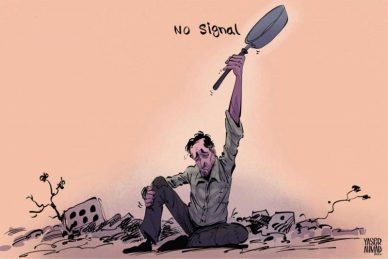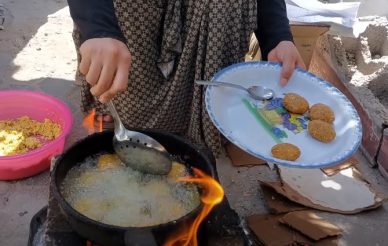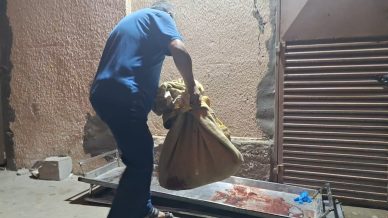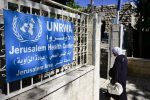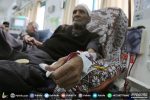GAZA, (PIC)
“Horrors that do not leave the memory, and we never imagined we would see in our lifetime.” This is perhaps the most prominent phrase in the testimonies of all the foreign doctors who, with tears and much pain, recount the medical tragedies and war crimes they witnessed while volunteering in hospitals in the Gaza Strip, which are overwhelmed to the point of being unable to treat the wounds of tens of thousands of injured due to the collapse of the healthcare system and 80% of it being out of service.
American doctor Ahmad Youssef documented rare scenes from Al-Aqsa Martyrs Hospital, one of the few hospitals still operating in Gaza, showcasing the horrific effects of war on civilians, especially children, and on the hospital staff.
A specialist in internal medicine and pediatrics who spent three weeks in Gaza stated in a testimony shared by The New York Times that Al-Aqsa Martyrs Hospital, which the occupying army ordered to evacuate the area around, is operating at three times its capacity in an effort to treat as many injured individuals as possible amid the ongoing Israeli bombardment.
He adds that due to the immense and ongoing pressure on the hospital, doctors are treating children on pieces of cardboard laid out in the hallways, amid a severe shortage of medical supplies such as anesthetics and blood units. “As a result, many patients died from their injuries.”
Youssef recounts with emotion how they were unable to do anything for a 23-year-old woman who arrived at the hospital with burns covering her body, only to discover afterward that she was pregnant, and she and her fetus breathed their last in their hands.
The American doctor sadly describes how a 12-year-old girl named Farah was martyred on the hospital floor in front of him due to a lack of resources, reminding him of his own daughter, who is the same size and is 10 years old. He notes that he still feels her hands around his neck as he writes his diary about her.
Yusuf continued, saying: “I witnessed everything I studied and learned about the burns that patients suffer from happening right before my eyes in a single day. Every time I think that the situation can’t get worse, it does,” indicating that the longer he spent there, the more he realized that his role was no longer just that of a doctor; he had turned into a witness to the horrors of the Israeli genocide in Gaza.
Yusuf confirmed that there was a choice to be made between the patients and the injured who periodically flooded the hospital due to the continuous Israeli bombardment. “Every hour, we make such decisions; who gets the ventilator, who receives a blood transfusion, and who gets the bed while patients lie on the floor.”
He said: “We no longer cry out of sadness. (but rather) It’s the feeling that we cannot compel the strongest country in the world to stop the bombs.”
Unimaginable things
As for American emergency physician Tami Abu Ghanim, who has been to Gaza twice in the past six months, she confirms that she witnessed immense suffering. “We tried to treat hundreds of children and women who sustained serious injuries from Israeli soldiers’ bullets, bombs, shrapnel, and debris from buildings.”
She explained that 60 to 70% of the injured coming from homes targeted by Israeli bombs were children, noting that during her most recent mission between July and August, she worked under extremely difficult conditions with Israeli soldiers present in Khan Yunis.
Abu Ghanim went on to say: “The things we saw in Gaza are unimaginable. Children are not getting basic nutrition. Every child needs psychological care that they won’t be able to receive for a very long time.”
The doctor added: “I cannot express how frustrating it is to know, as I stand in front of a patient removing shrapnel from her body, that the tax dollars I pay funded those shrapnel pieces.”
She recounted witnessing civilians and children intentionally targeted by occupation soldiers, children shot in the abdomen and chest, and Israeli mines exploding on children playing in a cemetery.
“An Injured Child Without a Family”
Pediatric intensive care doctor Tania Al-Haj Hassan brought tears to the eyes of the audience as she spoke about what she witnessed in Gaza during a Democratic Party conference.
Dr. Tania described how she held the hands of dying children “as they took their last breaths, with no family members alive to comfort them.” She expressed sorrow over the phenomenon of injured children arriving at the hospital alone, “to the extent that there a medical term was coined to describe them… an injured child, with no family alive.”
Tania says: “We have been trained to protect and preserve human life, but the Israeli military campaign targets life and everything necessary for its continuation in Gaza, making our work as doctors impossible.”
The American doctor continued: “I work with Doctors Without Borders, and during the genocide in Rwanda, they said that genocide requires an immediate radical response; doctors cannot stop genocide. I believe many of us feel the same way—we are terrified by what we are witnessing, and it haunts us in our dreams.”
Unconventional weapons
American surgeon Feroz Sidhu, who recently returned from the Gaza Strip, confirmed his witness to the deliberate killing of children by the occupation army and its use of unconventional weapons to target civilians and facilities.
About his time in Gaza, Sidhu said: “I worked for two weeks at the European Hospital last spring; the situation was catastrophic, and every day we witnessed massacres with mass casualties, most of whom were children suffering severe injuries from bombs that Israel receives from the United States.”
The American doctor described the weapons used by the Israeli occupation as “unconventional”, such as bombs that release shrapnel upon impact, leading to severe injuries. He talked about the most vivid scene in his mind: “There was an injured child from the shrapnel bombs, and I had to perform a difficult surgery on him. During the operation, the mother held her child, which encouraged him to endure the procedure. She refused to compromise her dignity and love for her children despite her own severe injuries.”
Medical shortages and strain
In April, Professor of Orthopedic Surgery at Cairo University, Ahmed Abdel Aziz, stated that the scale of the tragedies in Gaza is not reflected by the media. There is currently no way to remove the massive amounts of rubble from buildings that have become mass graves for entire families beneath them.
He confirmed that medical teams are suffering from severe shortages, which are decreasing due to the martyrdom and arrest of many of them. “The remaining ones are doing a remarkable job with utmost precision, but they are extremely exhausted and working with the available resources that are diminishing over time, as most injuries are accompanied by broken bones, exposed muscles, and severed arteries and tendons.”
Jordanian doctor Safi Ja’arah, a general and endoscopic surgeon, asserts that the volume of injuries exceeds the capacity of hospitals.
Safi, who volunteered in Gaza last March, indicated that the European Gaza Hospital had two hundred beds with 900 patients, most of whom remained in the hospital after discharge because they had nowhere to go because their homes had been shelled, and after being treated, the hospital remained overcrowded due to the numbers of patients and their families who filled the corridors and the hospital campus.
“Many of them have died, their relatives have arrived and returned to work, and some doctors have been in hospital for more than two months because there is nowhere to shelter,” he elaborated.
Memorable stories
Dr. Sam Al-Attar, who volunteered in Gaza last April, acknowledges that he left part of his soul in the Strip, “It was this part that saw the suffering and that he could not get away from it. The part that cannot now be forgotten”.
The surgeon says he sees the faces of Palestinians suffering in Gaza wherever he goes, of them, a mother who lost her child, who was 10 years old, “she was sobbing with lost glances as she said he died only 5 minutes ago, while the hospital workers were trying to cover his body, she was blocking them. Because she wants to spend as long time as possible with him.”
Sam remembers another experience saying, “A man in his 50s had amputated his legs, lost his children, grandchildren and home, he was alone in a secluded corner of the hospital, his wounds so contaminated that worms came out of it and he was screaming in pain.”
He says, “I still think about all the injured people and all the doctors who stayed there, and there’s an internal sense of guilt that I left despite their great need to be there, and yet I had to leave.”
American physician Mark Perlmutter, returning from Gaza last May, also relayed some details about the horrors of the Israeli massacres and crimes committed against the Gaza Strip’s inhabitants, considering them to be more than he had seen throughout his service in various countries around the world.
Perlmutter, an international orthopedic surgeon, emphasizes that the Israeli occupation army deliberately targeted children, “I saw a large number of burned and torn children in just the first week.”
The American doctor stated that he had seen children with missing parts of their bodies, and others crushed by buildings, some of whom were taken out by large bomb fragments.
He added that he had seen children targeted to death by sniper bullets, saying: “I have pictures of two children who were shot in the chest.”
Doctors who volunteered in Gaza have unanimously agreed that the health sector in the Gaza Strip has collapsed, making surgeries impossible despite the fact that those doctors have brought with them tons of medical equipment, but they are running out rapidly because of the increasing number of the wounded.
According to the Ministry of Health, more than 500 medical personnel in the Gaza Strip were martyred while most of the hospitals were knocked out of service.


